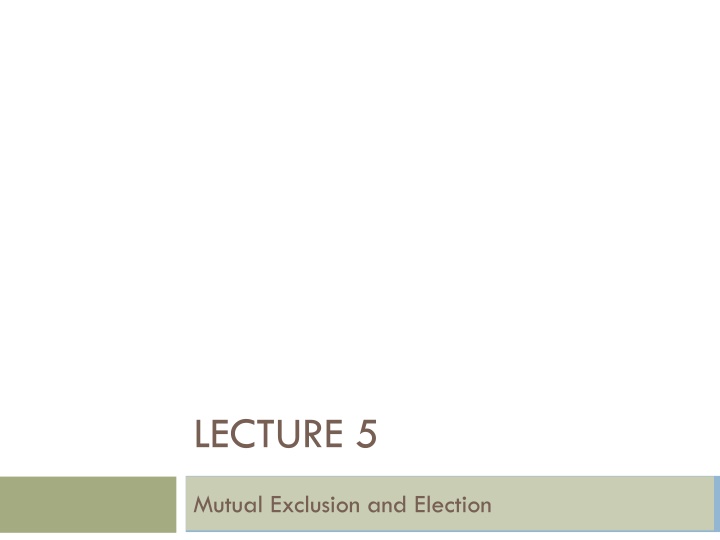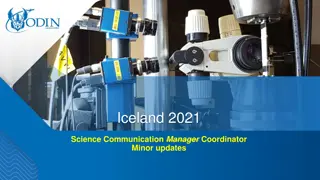
Mutual Exclusion and Coordination: Solutions for Shared Resource Access
Explore token-based and permission-based solutions for ensuring mutual exclusion in accessing shared resources, along with centralized algorithms for coordination and distributed systems using Lamport's clocks. Learn about receiver functions and coordination mechanisms to maintain fairness and prevent deadlock in resource access.
Download Presentation

Please find below an Image/Link to download the presentation.
The content on the website is provided AS IS for your information and personal use only. It may not be sold, licensed, or shared on other websites without obtaining consent from the author. If you encounter any issues during the download, it is possible that the publisher has removed the file from their server.
You are allowed to download the files provided on this website for personal or commercial use, subject to the condition that they are used lawfully. All files are the property of their respective owners.
The content on the website is provided AS IS for your information and personal use only. It may not be sold, licensed, or shared on other websites without obtaining consent from the author.
E N D
Presentation Transcript
LECTURE 5 Mutual Exclusion and Election
Shared resources 2 Processes may need to access the same resources. Concurrent accesses will corrupt the resource. Make it inconsistent (consistency later) Need for solutions that that facilitate coordination between different processes. Two different ways: Token based solutions Permission based solutions
Permission based approaches Process wanting to access a resource must first acquire permission from other processes. How to do so ? Various ways we will see.
Token-based solutions Mutual exclusion achieved by using a special message called a token Only one token available anyone who has the token can access the shared resource. Avoid deadlocks and starvation However, challenge when token is lost process holding the token can crash
A centralized algorithm Choose a coordinator (election later) A process that seeks to access a resource sends a message to the coordinator seeking permission. If no other process is accessing the resource, permission granted. (use a reply) If some other process is using the resource permission cannot be granted. How to handle is system dependent. e.g., just don t reply so that the requesting process blocks.
Coordination functions When resource is released, coordinator is notified. Coordinator picks first item off a queue of waiting requests and assigns resource. Easy to see mutual exclusion guaranteed. No starvation -- process is fair.
How to make it distributed? Use of Lamport s clocks Need total ordering of events Unambiguous which happened first When a process wants to access a resource, it builds a message which includes: Name of resource Process number current logical time. Send message to everyone else (broadcast) Assume reliable transmissions
Receiver functions If not accessing the resource and does not want to access it send OK Don t reply if accessing resource just queue request. If receiver wants to access resource, but has not done so: Compare time stamp with its own message (which it has sent everyone). If time stamp lower send OK (lowest timestamp wins) Else, queue request and send nothing.
Example of distributed algorithm Receiver waits until everyone gives permission. Once it gets, it accesses resource. Upon completion of usage, send OK to everyone in queue.
Message complexity The distributed algorithm guarantees mutual exclusion without starvation or deadlocks. Number of messages before resource acquisition: (N-1) requests to all other processes (N-1) OK messages from all other processes
Failures N points of failure Any process crash is wrongly interpreted as denial of permission. Blocks all subsequent attempts by processes to acquire resource. Patch: When a request arrives, receiver always grants or denies permission. If nothing is got within a time-out, keep trying until a reply is obtained, or the receiver is deemed dead.
Token ring A logical overlay (application level) ring is formed. Each process is assigned a position on the ring. Each one needs to know who is next in line after itself.
Token ring algorithm P0 is given a token which allows the process to access the resource. Upon completion, it passes it to P1 and the process continues. In general if there are N processes, P(k) P(k+1) mod N If a node that receives the token has no interest in the resource, it simply passes on the token on the ring. Nodes cannot immediately access the resource for a second time using the same token.
Issues Process with token might crash Hard to detect (process may still be accessing resource) Time bounds? ACKs If a process has to ACK token receipt lack of ACKs could help detect a dead process Remove dead process from the group.
Decentralized algorithm Each resource replicated N times and each has its own coordinator. When a process wants to access the resource, it needs OKs from m > n/2 coordinators for that resource. Majority vote When a permission has already been granted to a different process, coordinator tells requester.
Fault model When a coordinator crashes, it recovers quickly but forgets its vote (before crash) Thus, it may incorrectly grant permission again to another process after recovery. Recall: m coordinators had granted permission to the process accessing resource Let p = t/T be the probability of a coordinator reset. Then, probability k out of m coordinators reset is
Condition for correctness Let f coordinators fail; the remaining will be m-f. In order for this algorithm to work correctly, the remaining must still constitute the majority. That is m f > N/2 or f < m N/2 In order for a violation f m-N/2 and this occurs with a probability For typical values of N, m, T and t, these are quite small (e.g., for N= 16, m=9 T= 1 hour, t = 30 seconds), the violation probability is less than 10-18. Thus it can be often neglected.
Election algorithms As discussed, many algorithms require one process to act as a coordinator, initiator or perform some special role. If all processes are the same, how do we select this coordinator ? Assume that each process P has a unique identifier id (P). Election is to locate the process with the highest ID and designate it as the coordinator. Algorithms differ in terms of how they locate this highest ID Process.
The bully algorithm There are n processes [P0 Pn-1]. Let ID of Pk = k. An election is invoked when a process notices that the current coordinator is no longer responding to requests. The process Pk sends an ELECTION message to all processes with higher identifiers (Pk+1 and so on until Pn-1) If no one wins Pk wins and it becomes coordinator. Else, if one of the higher ups answers, it takes over. Pk s job is done.
Example Process 4 notices that the coordinator is not responding. It sends messages to processes 5, 6 and 7. 5 and 6 respond this is a cue for process 4 to withdraw.
Example (continued) Now, 5 and 6 hold an election 5 sends ELECTION messages to 6 and 7 6 sends ELECTION message to 7
Example (contd) Process 6 tells 5 to stop. There is no response from 7. This means process 6 has won the election. It tellls all other processes (bully them into submission )
Ring algorithm Election also could be based on a logical ring Note the physical topology is not a ring but they are logically organized that way. Does not use a token (like in token ring) Each process knows who is its successor. When a process notices that the coordinator is not functioning, it begins an election.
Election process The process that discovers the failed coordinator builds an ELECTION message contains its own ID (creates a list). Sends to successor. If successor is down, sender skips and goes to next member along the ring or one after that and so on until a running process is located. At each step, the process that sends adds its ID to the list in the message. When message returns to the process that initiated the election, it identifies the highest ID and chooses that process as coordinator. A new coordinator message is sent to everyone.
Example The example illustrates what happens when P3 and P6 discover simultaneously that the previous coordinator P7 has crashed. Note they converge to the same new coordinator (P6).






















